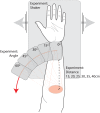Methodological concerns with laser speckle contrast imaging in clinical evaluation of microcirculation
- PMID: 28358906
- PMCID: PMC5373607
- DOI: 10.1371/journal.pone.0174703
Methodological concerns with laser speckle contrast imaging in clinical evaluation of microcirculation
Abstract
Background: Laser Speckle Contrast Imaging (LSCI) is a non-invasive and fast technique for measuring microvascular blood flow that recently has found clinical use for burn assessment and evaluation of flaps. Tissue motion caused by for example breathing or patient movements may however affect the measurements in these clinical applications, as may distance between the camera and the skin and tissue curvature. Therefore, the aims of this study were to investigate the effect of frame rate, number of frames/image, movement of the tissue, measuring distance and tissue curvature on the measured perfusion.
Methods: Methyl nicotinate-induced vasodilation in the forearm skin was measured using LSCI during controlled motion at different speeds, using different combinations of frame rate and number of frames/image, and at varying camera angles and distances. Experiments were made on healthy volunteers and on a cloth soaked in a colloidal suspension of polystyrene microspheres.
Results: Measured perfusion increased with tissue motion speed. The relation was independent of the absolute perfusion in the skin and of frame rate and number of frames/image. The measured perfusion decreased with increasing angles (16% at 60°, p = 0.01). Measured perfusion did not vary significantly between measurement distances from 15 to 40 cm (p = 0.77, %CV 0.9%).
Conclusion: Tissue motion increases and measurement angles beyond 45° decrease the measured perfusion in LSCI. These findings have to be taken into account when LSCI is used to assess moving or curved tissue surfaces, which is common in clinical applications.
Conflict of interest statement
Figures








Similar articles
-
Comparison of laser speckle contrast imaging with laser Doppler perfusion imaging for tissue perfusion measurement.Microcirculation. 2023 Jan;30(1):e12795. doi: 10.1111/micc.12795. Epub 2022 Dec 29. Microcirculation. 2023. PMID: 36524297 Free PMC article.
-
Comparison of laser speckle contrast imaging with laser Doppler for assessing microvascular function.Microvasc Res. 2011 Nov;82(3):326-32. doi: 10.1016/j.mvr.2011.07.007. Epub 2011 Jul 22. Microvasc Res. 2011. PMID: 21803051
-
Blood perfusion values of laser speckle contrast imaging and laser Doppler flowmetry: is a direct comparison possible?IEEE Trans Biomed Eng. 2013 May;60(5):1259-65. doi: 10.1109/TBME.2012.2232294. Epub 2012 Dec 10. IEEE Trans Biomed Eng. 2013. PMID: 23232361
-
Impact of experimental conditions on noncontact laser recordings in microvascular studies.Microcirculation. 2012 Nov;19(8):669-75. doi: 10.1111/j.1549-8719.2012.00205.x. Microcirculation. 2012. PMID: 22708898 Review.
-
Optical techniques for perfusion monitoring of the gastric tube after esophagectomy: a review of technologies and thresholds.Dis Esophagus. 2018 Jun 1;31(6). doi: 10.1093/dote/dox161. Dis Esophagus. 2018. PMID: 29701760 Review.
Cited by
-
Overview of the Assessment of Endothelial Function in Humans.Front Med (Lausanne). 2020 Oct 7;7:542567. doi: 10.3389/fmed.2020.542567. eCollection 2020. Front Med (Lausanne). 2020. PMID: 33117828 Free PMC article. Review.
-
Hyperspectral imaging in systemic sclerosis-associated Raynaud phenomenon.Arthritis Res Ther. 2023 Jan 20;25(1):10. doi: 10.1186/s13075-023-02990-3. Arthritis Res Ther. 2023. PMID: 36670487 Free PMC article.
-
Handheld versus mounted laser speckle contrast perfusion imaging demonstrated in psoriasis lesions.Sci Rep. 2021 Aug 17;11(1):16646. doi: 10.1038/s41598-021-96218-6. Sci Rep. 2021. PMID: 34404886 Free PMC article.
-
Wearable speckle plethysmography (SPG) for characterizing microvascular flow and resistance.Biomed Opt Express. 2018 Jul 30;9(8):3937-3952. doi: 10.1364/BOE.9.003937. eCollection 2018 Aug 1. Biomed Opt Express. 2018. PMID: 30338166 Free PMC article.
-
Real-time visualization of renal microperfusion using laser speckle contrast imaging.J Biomed Opt. 2021 May;26(5):056004. doi: 10.1117/1.JBO.26.5.056004. J Biomed Opt. 2021. PMID: 34024055 Free PMC article.
References
-
- Ambrozy E, Waczulikova I, Willfort-Ehringer A, Ehringer H, Koppensteiner R, Gschwandtner ME. Microcirculation in mixed arterial/venous ulcers and the surrounding skin: clinical study using a laser Doppler perfusion imager and capillary microscopy. Wound repair and regeneration: official publication of the Wound Healing Society [and] the European Tissue Repair Society. 2009;17(1):19–24. Epub 2009/01/21. - PubMed
-
- Lindahl F, Tesselaar E, Sjoberg F. Assessing paediatric scald injuries using Laser Speckle Contrast Imaging. Burns: journal of the International Society for Burn Injuries. 2013;39(4):662–6. Epub 2012/10/25. - PubMed
-
- Mirdell R, Iredahl F, Sjoberg F, Farnebo S, Tesselaar E. Microvascular blood flow in scalds in children and its relation to duration of wound healing: A study using laser speckle contrast imaging. Burns: journal of the International Society for Burn Injuries. 2016;42(3):648–54. Epub 2016/01/27. - PubMed
-
- Monstrey S, Hoeksema H, Verbelen J, Pirayesh A, Blondeel P. Assessment of burn depth and burn wound healing potential. Burns: journal of the International Society for Burn Injuries. 2008;34(6):761–9. Epub 2008/05/31. - PubMed
MeSH terms
Substances
LinkOut - more resources
Full Text Sources
Other Literature Sources

